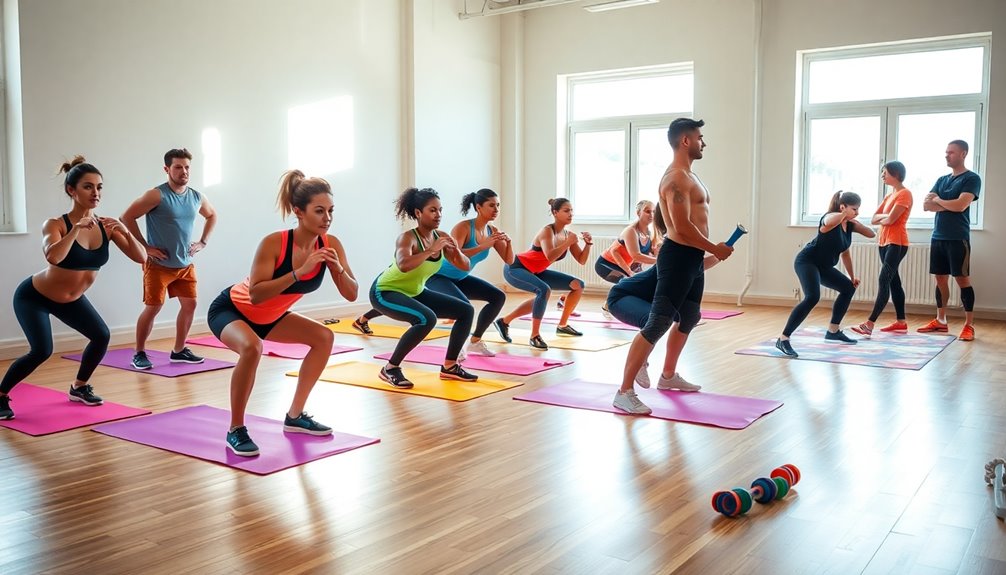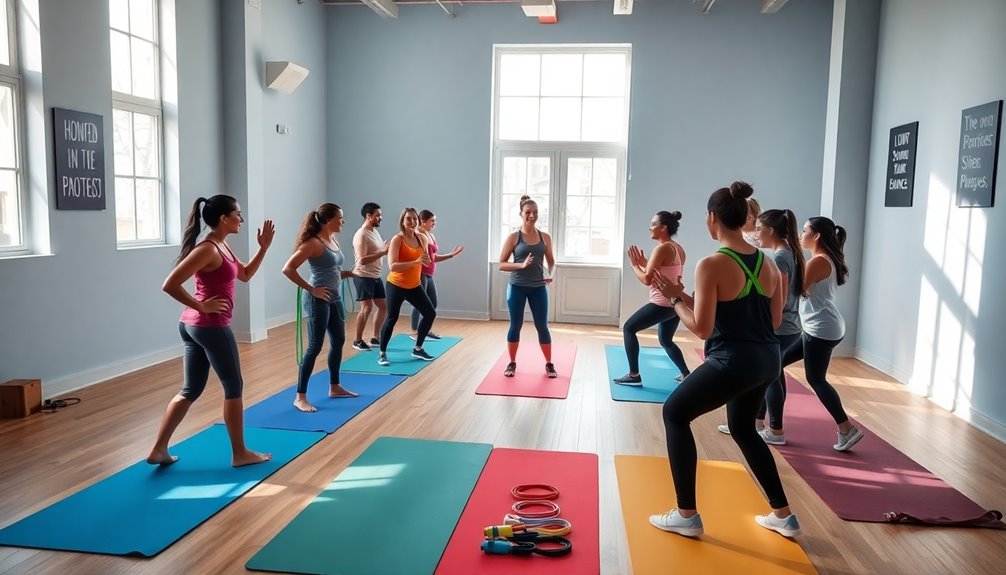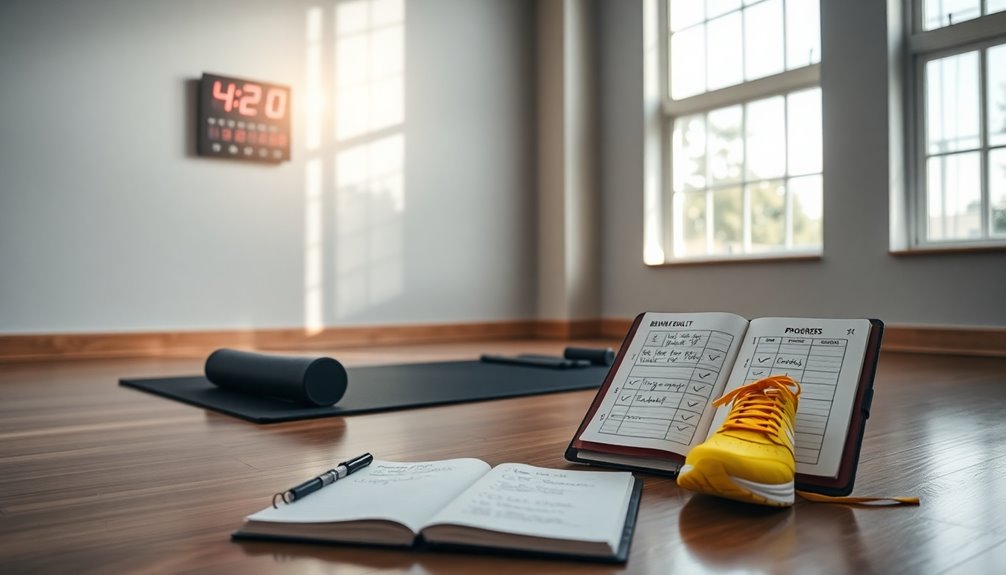To modify HIIT routines for beginners, start by choosing simple, bodyweight exercises that suit your current fitness level. Focus on engaging different muscle groups while keeping the intensity low. Gradually increase the difficulty as you build strength and endurance. Incorporate longer rest intervals to allow your body to recover, and listen to how you feel during each workout. Set realistic goals to stay motivated and celebrate your progress. Surround yourself with supportive people or groups to keep you inspired. Keep going, and you'll find more strategies to enhance your HIIT experience and reach your fitness goals.
Key Takeaways
- Start with low-impact exercises and bodyweight movements to ease into HIIT routines without risk of injury.
- Gradually increase intensity by listening to your body and adjusting workout duration or speed.
- Incorporate longer rest intervals to allow for recovery and maintain performance throughout the workout.
- Focus on engaging different muscle groups to create a balanced routine and prevent overexertion.
- Set realistic goals and track progress to stay motivated and celebrate small achievements.
Understanding HIIT Basics

Understanding the basics of High-Intensity Interval Training (HIIT) is fundamental for anyone looking to kickstart their fitness journey. HIIT involves alternating short bursts of intense exercise with periods of rest or lower-intensity activity. This method isn't just about getting sweaty; it's known for its numerous HIIT benefits. You'll find that it can boost your metabolism, improve cardiovascular health, and save you time, making it an attractive option for busy lifestyles.
However, it's pivotal to dispel some common HIIT misconceptions. Many think HIIT is only for the super fit or that it requires hours of commitment. In reality, you can tailor HIIT workouts to fit any fitness level and schedule. Whether you have 15 minutes or an hour, you can find a routine that meets your needs.
Another common misconception is that HIIT leads to burnout or injury. When done correctly, HIIT can be safe and effective. It's all about listening to your body and modifying exercises as needed. Start with lower intensity and gradually increase as you feel comfortable. Incorporating tools like mini bands can enhance your workouts, offering a unique challenge with elastic resistance for effective muscle toning.
Assessing Your Current Fitness Level

Before diving into HIIT, evaluating your current fitness level is necessary. This step isn't just about knowing where you stand; it's about assessing your capabilities so you can set realistic benchmarks for your fitness journey. Understanding your starting point will help you tailor your HIIT routine to your needs and make sure you progress safely.
To help you evaluate your fitness level, consider the following table that outlines common fitness indicators and how to assess them:
| Fitness Indicator | How to Assess | Benchmark Example |
|---|---|---|
| Cardiovascular Endurance | 1-mile run time | Under 10 minutes |
| Strength | Maximum push-ups in 1 min | 15 push-ups |
| Flexibility | Sit and Reach test | 12 inches beyond toes |
| Balance | One-leg stand time | 30 seconds |
By reviewing these indicators, you can gain insight into your strengths and areas for improvement. It's important to be honest with yourself during this evaluation. Remember, everyone's journey is different, and there's no rush to hit elite levels right away. A strong core is essential for overall stability and can enhance your performance in HIIT workouts.
Once you've assessed your fitness level, you'll have a clearer idea of what you can achieve with HIIT. Keep in mind that setting benchmarks will not only motivate you but also create a sense of belonging within your fitness community. Embrace the process, and enjoy the journey ahead!
Choosing Appropriate Exercises

Now that you've evaluated your fitness level, it's time to select exercises that match your capabilities and goals. Choosing the right moves is essential for your success and enjoyment in HIIT training. Focus on beginner-friendly moves that allow you to build confidence and strength without feeling overwhelmed.
Start with exercises that utilize your body weight, like squats, push-ups, or lunges. These foundational movements can be easily adjusted to suit your current fitness level. For example, if a standard push-up feels too challenging, try doing them on your knees. These exercise adjustments ensure you're still getting a great workout while accommodating your needs.
Incorporate low-impact options too, such as step-ups or modified burpees, which reduce stress on your joints while still increasing your heart rate. Additionally, remember that engaging your glutes during these movements can enhance your overall performance and help prevent injuries related to weak glutes.
You can mix in exercises that engage different muscle groups, balancing upper and lower body movements. This variation keeps your routine interesting and helps you avoid plateaus.
Adjusting Workout Intensity

To effectively customize your HIIT routine, tweaking workout intensity is crucial to ensuring you progress while staying motivated. As a beginner, finding the right balance between challenge and comfort is vital. Intensity modification can assist you in gradually enhancing your fitness level without overwhelming yourself. Begin by evaluating your current fitness level and selecting exercises that feel manageable yet slightly demanding.
When you're just starting out, beginner adjustments can make all the difference. Instead of diving straight into high-impact movements, consider lower-intensity alternatives. For instance, if burpees feel too strong, try stepping back into a plank position instead of jumping.
Similarly, during sprints, focus on maintaining a brisk walk or light jog, gradually boosting your speed as you become stronger.
It's also beneficial to tune in to your body. If you're feeling fatigued, don't hesitate to dial down the intensity. This isn't about pushing through discomfort; it's about discovering what works best for you. Remember, each workout is a step toward improving your fitness, so acknowledge your progress, no matter how minor. Studies show that snoring prevalence affects a significant portion of the population, which can also impact their fitness journey.
As you grow more at ease with your regimen, you can progressively ramp up the intensity. This could involve adding more repetitions, increasing your pace, or incorporating more demanding exercises. By adjusting workout intensity, you'll not only enhance your fitness but also cultivate a sense of achievement that keeps you motivated. Embrace the journey, and recall, everyone starts somewhere!
Incorporating Rest Intervals

Incorporating rest intervals into your HIIT routine is necessary for maximizing your performance and recovery. When you push yourself during high-intensity intervals, your muscles need time to recover and adapt. By resting strategically, you're not only allowing your body to catch its breath but also promoting recovery, which is essential for your overall progress.
Start by determining the length of your work intervals and matching them with appropriate rest periods. For beginners, a common approach is a 1:2 work-to-rest ratio. This means if you're working hard for 30 seconds, you'd rest for 60 seconds. This gives your body enough time to recuperate while still keeping you engaged and challenged.
It's also important to listen to your body. If you feel fatigued or your form starts to suffer, don't hesitate to extend your rest intervals. Remember, this journey is about building a sustainable routine, not just pushing through each session. By allowing adequate recovery, you'll prevent injuries and set yourself up for greater gains over time.
Incorporating rest intervals not only boosts your physical performance but also keeps you mentally fresh. It can be motivating to see how those short breaks enhance your ability to push harder during the next round. You're part of a community that understands the importance of balance in fitness. Additionally, embracing mindful practices, like brainwave guidance technology, can enhance your overall recovery and mental focus. So, embrace those rest periods—they're a necessary part of your journey toward achieving your goals!
Setting Realistic Goals

Setting realistic goals is vital for your success in HIIT training. As a beginner, it's easy to feel overwhelmed by the intensity of these workouts. However, effective goal setting can help you stay motivated and focused. Start by identifying what you want to achieve—whether it's improving your endurance, losing weight, or simply feeling more energetic. Break these larger aspirations into smaller, manageable goals that you can realistically reach within a specific timeframe.
For instance, instead of aiming to complete a 30-minute HIIT session right away, aim to start with 10-minute sessions and gradually increase the duration. This approach not only makes your goals attainable but also boosts your confidence as you see progress. Incorporating exercise and workouts tailored to your individual goals can further enhance your training experience.
Progress monitoring is another vital aspect. Keep track of your workouts, noting down the exercises, durations, and how you felt afterward. This will help you identify patterns and areas where you can improve.
Celebrate small victories along the way, like completing an extra set or increasing your workout time. These moments of achievement reinforce your commitment and remind you that you're moving forward.
Building a Supportive Environment

A supportive environment can greatly enhance your HIIT journey, making it easier to stick to your goals. Surrounding yourself with encouraging individuals can be the difference between giving up and pushing through those tough workouts. You're more likely to stay committed when you're part of a community that shares your fitness aspirations.
Start by seeking out friends or family who are interested in joining you. Working out together creates a sense of camaraderie, making it easier to stay motivated. You can cheer each other on, celebrate small victories, and share tips on improving your routines.
This shared experience not only builds bonds but also fosters accountability. When you know someone else is counting on you, you're less likely to skip a session.
If you can't find workout buddies in your immediate circle, consider joining local fitness classes or online communities. Many groups focus on beginners, providing a welcoming space for you to connect with others who understand the challenges you face. Additionally, you can explore online support communities that offer resources and motivation for your fitness journey.
Engaging with these communities can spark inspiration, helping you stay excited about your progress.
Tracking Your Progress

Tracking your progress is essential for staying motivated and understanding your growth in HIIT. By keeping a close eye on your performance, you'll not only celebrate your achievements but also identify areas for improvement. Setting benchmarks is a great first step in this journey. These benchmarks can include metrics like the number of reps you can complete, the duration of your workouts, or even your heart rate during exercises.
To help you visualize your progress, consider using a simple table. Here's an example:
| Date | Benchmark Set | Improvements Noted |
|---|---|---|
| Week 1 | 10 burpees | Completed in 1 minute |
| Week 2 | 15 burpees | Completed in 50 seconds |
| Week 3 | 20 burpees | Completed in 45 seconds |
Monitoring improvements over time keeps you accountable and encourages you to push your limits. As you fill in your table, you'll see how far you've come, which can boost your confidence and keep you engaged with your training. Additionally, incorporating mind/body exercises alongside your HIIT routine can further enhance your overall performance and support blood pressure management.
Frequently Asked Questions
Can I Do HIIT Workouts at Home Without Equipment?
Absolutely, you can do HIIT workouts at home without equipment! Focus on bodyweight exercises like squats, lunges, and burpees for effective home modifications. You can also use equipment alternatives like a sturdy chair for step-ups or a towel for sliding exercises.
How Often Should Beginners Practice HIIT Each Week?
When you're starting your journey with HIIT, think of it like planting a seed; you want to nurture it. Aim for about two to three sessions a week, allowing your body ample recovery time to flourish.
As you progress, you can gradually increase your frequency, listening to what your body tells you. This balanced approach helps prevent burnout and keeps you motivated, making the experience enjoyable and sustainable for you.
What Should I Eat Before and After HIIT Workouts?
Before your HIIT workouts, you should grab a pre-workout snack that includes carbs and protein, like a banana with nut butter. It'll fuel your energy and keep you going strong.
After you finish, refuel with a post-workout meal rich in protein and healthy fats, such as grilled chicken with quinoa and veggies. These choices help your body recover and build muscle, keeping you motivated and ready for your next session!
Are There Any Safety Precautions for HIIT Beginners?
If you're new to HIIT, safety's essential. Start each session with warm-up exercises to prepare your body and reduce injury risk.
Focus on proper form throughout each movement; it'll help prevent strain and maximize your workout.
Listen to your body—if something feels off, don't hesitate to take a break.
How Do I Know if I'm Overdoing My HIIT Sessions?
Did you know that about 30% of fitness enthusiasts push themselves too hard during workouts? If you're feeling signs of exhaustion like extreme fatigue or persistent soreness, it's a sign you might be overdoing your HIIT sessions.
Pay attention to your body; if you're facing injury or discomfort, it's time for adjusting intensity or duration. Remember, finding the right balance is essential for your growth and well-being in fitness. Keep pushing, but be smart!
Conclusion
Incorporating HIIT into your routine can be a game-changer, especially for beginners. Did you know that just 15 minutes of high-intensity interval training can burn as many calories as an hour of steady cardio? By understanding the basics, evaluating your fitness level, and adjusting your workouts, you can make HIIT accessible and effective. Remember, it's about progress, not perfection. Stay consistent, track your improvements, and enjoy the journey to a healthier you!



